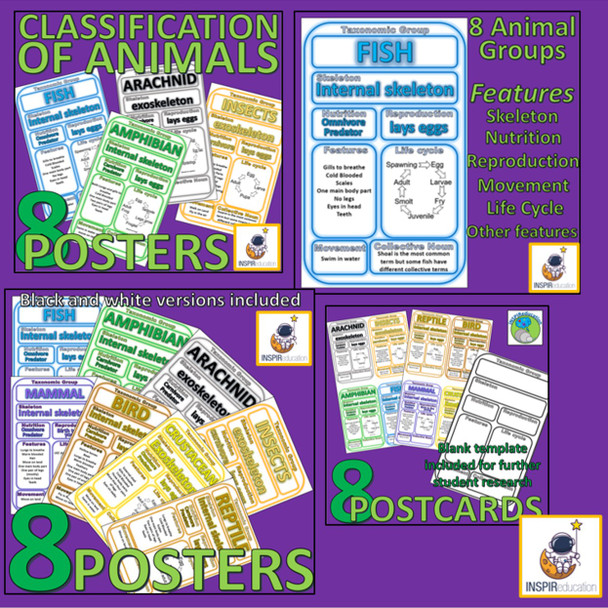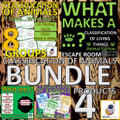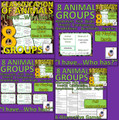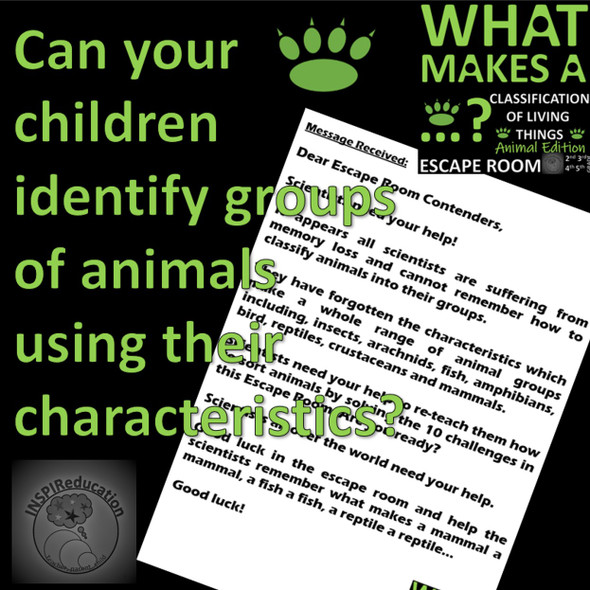Description
This bundle brings together four of our all year round popular products linked to classification of animals into their taxonomic groups. In focusing on 8 different animal groups including: arachnids, mammals, insects, reptiles, amphibians, birds, fish and crustaceans, students learn about the features which are specific to each animal type. This will include appearance, feeding, reproduction, breathing, movement and life cycle.
We have used these products with our students over many years and each has a vital role to play in developing their knowledge into the classification of living things (animals).
Included within this produce:
- Escape Room: Classification of Animals
- 8 Poster Set (color and black and white versions)
- "I have... Who has...?" 49 Card Game Set focusing on the 8 taxonomic groups.
- "What am I?" Yes/No Question Game (Decision Tree Design maker)
Further details of each can be found below:
WHAT MAKES A ... A...? Escape Room - Characteristics of Living Things
Using an Escape Room to develop curriculum knowledge is an exciting activity that will inspire learners from 2nd Grade to 5th Grade.
The curriculum content of this Escape Room is linked to:
- Characteristics of Living Things (Animals)
The aim of the Escape Room is to provide jeopardy for the children to work under pressure to solve 10 clues to help scientists who have forgotten how to classify animals using a wide range of characteristics based on the features of all living things (move, reproduce, sensitivity, grow, respire, excrete and nutrition).
Before beginning, you will need to prepare the following:
- A copy of the Pupil Workbook for each group
- A set of table activities for every group – prepared beforehand and given to each group after they have all completed each Code Key activity
- IT sources and research materials
- Initial Starting Script sharing the problem to the children
- Completion Script celebrating the completion of the challenge
Children do not need prior knowledge of the topic above to complete this Escape Room, as the research will support the answers and each Code Key is supported with several clues. This Escape Room is ideal as a review of learning.
The activity begins by the teacher reader the Initial Message received. It clearly tells the children that they are required to help scientists to classify animals – as for some reason, all scientists have lost the ability and memory to sort animals and place them into their taxonomic groups! The only way they can do this is to solve the 10 challenges within this Escape Room. Failure is not an option!
What follows are 10 challenges which the children must solve to discover the code to move onto the next activity.
Each activity focuses and builds the children’s knowledge on many aspects of classification of animals.
The 10 activities are based on the following outcomes:
- Know the 7 main features of all living things
- Understand that animals can be grouped into taxonomic groups (arachnid, bird, amphibian, insect, mammal, crustacean, fish and reptiles). The activity can be extended to included other animal groups should the teacher wish to develop it further to add other animal groups)
- What makes an insect an insect?
- What makes an arachnid an arachnid?
- What makes a fish a fish?
- What makes an amphibian an amphibian?
- What makes a bird a bird?
- What makes a reptile a reptile?
- What makes a crustacean a crustacean?
- What makes a mammal a mammal?
When all 10 activities are completed, and the children have gained the correct Code Keys from each activity, the teacher can read the final communication detailing how the children have been able to help the scientists to continue their important work.
Setting up the Escape Room
- Children should be split into groups of no more than four and be placed in their own work space.
- Access to IT and research materials should be provided to allow children to research answers to questions and review their own knowledge, as well as checking answers.
- Each group should have a Code Key Booklet and decide on a team name
- Read the Initial Message to the children to set the challenge in context. Discuss what this means, and what the activity entails.
- Hand each group a copy of Code Key 1. Agree with the children a set time to complete the problem in – this ensures that the children stay on task and maintains the Escape Room element of working under pressure.
- At the end of the time, children should have filled in the Code Key in their booklet. The teacher can then check the accuracy of all the groups and talk through the responses the children should have.
- Move on through the remaining challenges until all 9 have been completed.
- For those groups who have been successful, they are then able to read the completed statement where they find out if they have escaped the Escape Room and saved the Earth!
There are other ways of running Escape Room activities, for example, each activity could be set up on 10 tables and the children then move from table to table completing the activity. This would reduce the need for as many resources, and access to non-fiction sources and Internet Resources could then be targeted at specific Challenges.
"I have... Who has...?" 49 Card Game Set focusing on the 8 taxonomic groups.
This product has been devised to support students learn and remember the key characteristics of living things focusing on eight animal taxonomic groups in a fast, fun and exciting set of games. Animal groups included are:
- Mammals
- Insects
- Arachnids
- Reptiles
- Birds
- Crustaceans
- Amphibians
- Fish
This product enabled our students to really engage in their learning and build up clear knowledge of the features of the eight animal groups included.
This Product Includes:
- Instructions on how to use and play this product – including variations on the game to reinforce and embed the learning in different scenarios
- 49 color playing cards and 5 spare cards for additional student clues
- 49 black and white playing cards and 5 spare cards
Before Playing:
Preparation is easy, simply download and print the format you require (color or black and white version) of the game.
Cut the cards to size.
We also recommend that the cards are laminated to ensure that they are protected and last for many years to come!
Instructions for playing:
Ideal for whole class activities, groups, pairs or solo playing. Each card is divided into two sections - a clue and an answer.
Whole Class Game
- Share the cards out between the students ensuring that the class teacher also has a card. One card for each student.
- On playing the game for the first time, the teacher reads their “What am I?” clue and asks the students to look at the answer side of their card “Animal Taxonomic Group” to see if the clue given by the teacher matches their animal group.
- If the answer matches the clue given, the student shouts out the Taxonomic Group and then asks their What am I? question.
- The game is continued to be played until time runs out, or all the students have asked their questions, or all the taxonomic groups have been revealed.
Small Group Games (1)
As above, the same rules apply, but the students now sort the cards into the answer piles with each student having one animal group each, for example, one player has all the fish cards, the next player has all the mammal cards and so on. Up to 8 players can play within the group game.
- Decide which player starts the game.
- That player reads the first clue and the other players look for the answer on their cards. The first to find the answer within their specific answer then reads their clue.
- When a clue is read, the player must turn that card over and not to be used again.
- The winner is the first player to read all of their clues and have all of their playing cards turned over.
Small Group Games (1)
As the class game, but this time, share all of the cards out between the players.
Decide which player starts the game.
- That player reads the first clue and the other players look for the answer on their cards. The first to find the answer within their specific answer then reads their clue.
- When a clue is read, the player must turn that card over and not to be used again.
- The winner is the first player to read all of their clues and have all of their playing cards turned over.
Paired Game
Divide the cards into two piles.
- The first player lays down a card with the question and the answer both showing.
- Player two then looks at their cards and can lay down either a question which links to the answer, or an answer which links to the question.
- If player two cannot go, player one steals the turn and lays down either an answer or a question
- The game continues to be played until the first player to lay all of their cards is declared the winner.
- In the event of neither player being able to lay a card, the winner is the player with the least amount of card.
Paired Game (2)
Decide which player is the quiz master and which is the game player.
- Quiz master reads a clue
- Game player has to decide which animal is being described
- Game play continues until the game player makes a mistake.
- When a mistake is made, the roles swap and the new game player tries to beat the score of the first player.
- Continue playing and swapping until all of the cards are used.
- The winner is the player with the most cards.
Individual game
Like dominoes, this game is ideal for one player.
- Take all the cards and spread them onto a flat surface, face up.
- Select one card to place at the center of the flat surface.
- Link a card to either the question or the answer.
- Continue to play until all the cards are used up.
- When the play can carry on no further – and cards are left – edit the sequence of questions to try and lay more cards.
This product has lots of possibilities for game playing. Whilst we have listed six in the instructions, teachers and students will be able to devise their own variations and brand-new games. Each game provides students with opportunities for supporting the developing knowledge of the characteristics of living things (animals and their taxonomic groups). Our students loved these cards and the activities that we developed together - they certainly knew their characteristics of animals!
Classification of Animals - Classroom Posters (8)
We have devised this product to support our own teaching in supporting students classifying animals into different groups. Having already produced decision trees, games and an Escape Room, we turned our attention to posters and postcards to support our students visually within the classroom.
We have produced 8 different posters for the following animal groups:
- Mammal
- Bird
- Reptile
- Fish
- Amphibian
- Crustacean
- Arachnid
- Insect
Each poster focuses on the features of the animals which make it that kind of animal - asking the question - "What makes a falcon a bird?", or "What makes a spider an arachnid?" and so on.
The features we have included are:
- Taxonomic group name
- Skeleton type (exoskeleton, internal skeleton, shell)
- Nutrition (herbivore, carnivore, omnivore, predator)
- Reproduction (lays eggs, gives birth to live young)
- Features (physical, blood type - cold or warm blooded, ability to breathe)
- Life cycle diagram
- Movement
- Collective noun (if specific to the group rather than individual animals)
Not only this, but we have included a black and white version of all of the posters, as well as a blank template to support either a research project for students before revealing the answers on the posters, or to extend the learning to other taxonomic groups - or even to plants.
Alongside the posters (color and black and white) and the template for further research, we have also included postcard versions of the posters to be able to allow the students to have their own copies in order to revise the characteristics of each group. Our students tooks these home and it supported home based learning, as well as being included in our Science Center activity bank.
We hope that you will find these posters and postcards useful in your classroom and in supporting the learning of your students.
"What am I?" YES/NO Question Game
We devised this game to support our children's questioning skills, deduction skills and characteristics of animal knowledge with key features and names of each major group. We have taken the existing version of the well known party game and updated it for the classroom/learning environment.
We have provided 56 Animal Name cards which players use to ask questions about - but where we have developed the game, to support learning and questioning, is to provide the children with 5 question openers - supporting their questioning skills, and 43 vocabulary cards related to the features and characteristics of animals. This takes the game to the next level and focused on embedding learning of the topic, questioning skills and deducing answers from the information gained.
Once purchased and downloaded, open the ZIP and open the main document.
Print the document in colour to support the color coded vocabulary, hint and shape name cards– 35 pages of resources and instructions.
To maintain the quality of the resources when using on a regular basis, laminate each page to keep the resource in good condition for longer. This will also strengthen each of the cards without having to print on card.
Once printed and laminated, cut each of the cards out. You should have:
- 56 animal name cards for game playing
- 43 Handy Hint Vocabulary cards to support questioning
- 5 Question Starter cards to support developing higher order questioning
- 6 “cut out and make” card stands for players to place their 2D and 3D shape name card on.
Your resource is now ready for use.
The game is easy to play and designed for up to 6 players (but this can also be played in smaller and larger groups, including the whole class, with one child asking the questions and the rest of the class answering them).
Before playing:
1) Set out the game cards at the beginning of play. The 56 animal name game cards should be in a pile, faced down so that no-one can see the name of the shape being picked.
2) Both the 43 Handy Hints Vocabulary cards and the 5 question starter cards should all be face up and separated so that each player can see the cards.
3) Each player should have a stand in front of them, facing away from them.
4) Decide which player is going to start. Order of play will then move clockwise from the first player.
5) Decide who will tally the number of questions asked for each player.
You are now ready to play.
6) Player one takes a card from the pile of Animal Name cards and – without looking at the card, places it on the stand so that all of the other players can see the card.
7) Player one then starts asking a series of questions to try and work out the name of the animal on their game card.
8) For each question asked, the answer from the other players can only be “yes” or “no”.
9) After each question has been asked, the scorer records a tally.
10) Once the player has guessed correctly the name of the animal, the scorer adds up the amount of questions and that is the score for that player.
11) The next player then repeats these steps.
12) Game play continues until all the cards have gone, or the players have played an equal number of cards each.
13) The player with the least number of points/questions asked is the winner.
Alternative game playing
1) You can also play this game in the inverse where player one takes the card and does not show the other players. Instead, the other players take it in turns to ask questions about the animal. Each question asked is a point to the player who asked it. The round stops when the animal has been guessed. The person who guessed the animal takes one mark from their total.
2) The class teacher can also pick a card and ask specific children to ask a question about the animal. Children can keep asking questions until the animal has been guessed.
3) The class teacher can take a card and they can start describing the animal using scientific properties. The first child to guess the name of the animal correctly is the winner.
This product can be used as a Science Center, early morning activity or early finisher resource to support learners who are independent, as well as a whole class activity.
Our students have loved using each and every one of these products. They make great games and resources to send home, or use for remote learning. They are also ideal for introducing and modelling new vocabulary as well as both science and literacy centers.
Best wishes
INSPIReducation




















